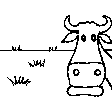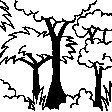

Area enclosure is done in low grazing range lands of average slope 2 – 5%. Enclosure is done by demarcating the fragile land that has direct impact to the riverine ecosystem. The land is exposed to degradation through overgrazing and soil compaction by livestock, bush fire, river bank erosion and reduced quality of pasture spps. Demarcation is done by planting trees in identified area situated about 300 meters from the riverine buffer zone. The preferred plants are Ficus thonigii. The average space between trees is 2 meters. Physical enclosure is supported and enhanced by use of protective bylaws. Reseeding of nutritious pasture species is also done and the area is left under protection for growth and regeneration of mulch, pastures and other vegetation to take place. The common pasture species reseeded are Leucaena spp, cannavaria brazile, clitoria tenatea, sesbania sesban, stylothensis, cajanus cajan, chloris gayana, branchalia spps . Direct grazing is prohibited and mulch and pasture materials are accessed through controlled and organized cut and carry.
Area enclosure is meant for rehabilitation of the riverine ecosystem and prevention of further degradation. Mulch and high nutritious pasture materials that are accessed through organized cut and carry procedures improve crop and animal productivity and have both direct and indirect impact to diversification of income sources and thus play significant role in putting the triple win solution into reality.
Purpose of the Technology: Purpose: 1) To improve vegetative cover, reduce soil erosion and prevent and rehabilitate degradation of the riverine ecosystem 2) Ensure sustainable availability and accessibility of mulch and nutritious pasture that are need for increased crop and livestock productivity 3) Promote use of environmental friendly exploitation of land resources (i.e. mulch, pasture, grass carpeting and other materials) and 4) Promote direct and indirect diversification of income sources.
Establishment / maintenance activities and inputs: Establishment and recurrent activities includes: area identification and measurement; slashing and land preparation for boundary tree planting and pasture reseeding; collection of planting materials and planting along defined boundaries for demarcation; procurement of seed and reseeding of nutritious and palatable pasture species; selective weeding; area reshaping and gap filling.
Natural / human environment: Bio-physically the area is semi natural grassland with grasses and shrubs trees. The technology is a combination of management and vegetative measure (area enclosure, demarcation using ficus thonigii and reseeding of nutritious pasture). Climatic zone is sub humid with 210 length of growing period (LGP). Slope category is gentle lying between 2-5%. Soil texture is fine heavy (clay) with medium soil depth.
Social economic wise the area is dominated by handy tools typology of mechanization. Production system is mixed (both for subsistence and commercial purposes). Inputs used includes tools (hand hoe, machete, sickles, spade and mattock), light and heavy labour, pasture seeds and tree planting materials with average annual costs of 1084.3 USD per hectare. Land ownership in technological area is communal.

Lugar: Missenyi distict/Minziro ward/Minziro village, Tanzania/Kagera, Tanzania, República Unida de
No. de sitios de Tecnología analizados:
Difusión de la Tecnología: distribuida parejamente sobre un área (approx. < 0.1 km2 (10 ha))
¿En un área de protección permanente?:
Fecha de la implementación: hace menos de 10 años (recientemente)
Tipo de introducción









| Especifique insumo | Unidad | Cantidad | Costos por unidad (Tanzanian shillings) | Costos totales por insumo (Tanzanian shillings) | % de los costos cubiertos por los usuarios de las tierras |
| Mano de obra | |||||
| Site/boundary identification | Mandays | 15,0 | 1,13333 | 17,0 | 100,0 |
| Site preparation for reseeding and demarcation (slashing, selective tilling, hole digging) | Mandays | 15,0 | 3,9213 | 58,82 | |
| Planting of demarcation trees, leguminous shrubs and grass pasture | Mandays | 15,0 | 3,9213 | 58,82 | |
| Fertilizer application (DAP) | Mandays | 15,0 | 1,13333 | 17,0 | |
| Equipo | |||||
| Tools | Number | 5,0 | 3,0 | 15,0 | 100,0 |
| Material para plantas | |||||
| Seeds | ha | 1,0 | 235,29 | 235,29 | |
| Seedlings | ha | 1,0 | 117,65 | 117,65 | |
| Fertilizantes y biocidas | |||||
| Fertilizer | kg | 125,0 | 0,588 | 73,5 | |
| Otros | |||||
| Meeting on awareness creation and formalization of the practice (change of resource use practice) | Mandays | 15,0 | 3,9213 | 58,82 | 100,0 |
| Costos totales para establecer la Tecnología | 651.9 | ||||
| Costos totales para establecer la Tecnología en USD | 0.38 | ||||
| Especifique insumo | Unidad | Cantidad | Costos por unidad (Tanzanian shillings) | Costos totales por insumo (Tanzanian shillings) | % de los costos cubiertos por los usuarios de las tierras |
| Mano de obra | |||||
| Selective weeding and gap filling | Mandays | 15,0 | 1,76466 | 26,47 | 100,0 |
| Supervision and monitoring | Mandays | 15,0 | 3,53 | 52,95 | 100,0 |
| Organized cut and carry of Mulching and pasture materials | Mandays | 10,0 | 17,647 | 176,47 | 100,0 |
| monitoring area closure and organized cut and carry | Mandays | 10,0 | 17,647 | 176,47 | 100,0 |
| Indique los costos totales para mantenecer la Tecnología | 432.36 | ||||
| Costos totales para mantener la Tecnología en USD | 0.25 | ||||
Cantidad antes de MST: 5.0 ton/ha
Cantidad luego de MST: 6-7.0 ton/ha
due to the availability and use of mulching by some farmersmaterials
Cantidad antes de MST: 2 acres/annum
Cantidad luego de MST: 10 acre/annum
area enclosure and decline of forest fire
Cantidad antes de MST: 3
Cantidad luego de MST: 8
increase in the number of nutritiuos pasture species due to reseeding
Cantidad antes de MST: 1200litres/cow/yeer
Cantidad luego de MST: 2000litres/cow/year
Contribution of nutritious cut and carry pastures
Cantidad antes de MST: high
Cantidad luego de MST: low
availability of manure from animal kept under zore grazing
Cantidad antes de MST: low
Cantidad luego de MST: high
Income accrued from sell of mulching and pasture materials.
Cantidad antes de MST: weak
Cantidad luego de MST: strong
empowerment and capacity building of environmental committee.
The technology has contributed to availability and accessibility to mulching and nutritious pasture that are need for increased crop and livestock productivity. This has both direct and indirect impact on the income of the community and hence livelihood (e.g. ability to meet education and health expenses).
Cantidad antes de MST: low
Cantidad luego de MST: high
Reduction in uproductive loss of both green and blue water.
Cantidad antes de MST: high
Cantidad luego de MST: low
Resultant of vergetation cover
Cantidad antes de MST: high
Cantidad luego de MST: low
Reduce uproductive evaporation due vegetation cover
Cantidad antes de MST: low
Cantidad luego de MST: high
Improved vegetation cover
Cantidad antes de MST: high
Cantidad luego de MST: low
Cotrolled soil erosion due to runoff
Cantidad antes de MST: high
Cantidad luego de MST: low
Reduced overgrazing and animla trumpling
Cantidad antes de MST: high
Cantidad luego de MST: low
Reduced overgrazing and animla trumpling
Cantidad antes de MST: low
Cantidad luego de MST: high
Controlled fire burning
Cantidad antes de MST: high
Cantidad luego de MST: low
Controled bush fire
Cantidad antes de MST: high
Cantidad luego de MST: low
harzards due to bush fire but reduced due to enclosure, fire break and use of bylaws.
Cantidad antes de MST: high
Cantidad luego de MST: low
Resultant of improved vegetation cover and controlled erosion
Cantidad antes de MST: high
Cantidad luego de MST: low
Resultant of improved vegetation cover and controlled erosion